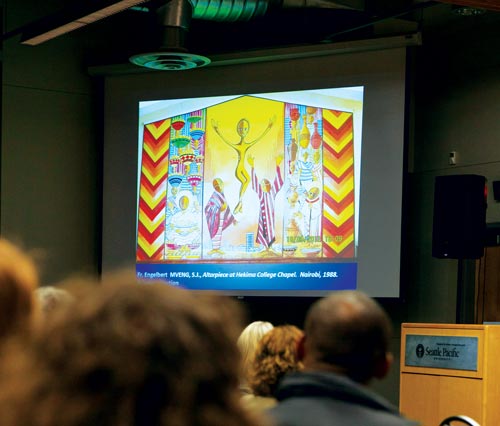The Bible & Theology Toward Christian Maturity
Palmer Lecture 2016: A Theologian Explores the Arts
Looking to the arts, a theologian explores when truth goes beyond words in his 2016 lecture
By Hannah Notess | Photo by Zac Davis
 An altarpiece in Nairobi, Kenya, was an example of art that communicated theology, shown during the 2016 Palmer Lecture.
An altarpiece in Nairobi, Kenya, was an example of art that communicated theology, shown during the 2016 Palmer Lecture.
A respected theologian and teacher, Fr. Eduardo Fernández looked outside of his own academic discipline for inspiration when giving Seattle Pacific Seminary’s 39th annual Alfred S. Palmer Lecture this February. Fernandez is associate professor of pastoral theology and ministry at Jesuit School of Theology of Santa Clara University and the author of a number of scholarly books and articles. But sometimes, he said, in his lecture, “art is the only way we can communicate something.”
“Mystery is not a puzzle to be solved,” he said. “It is a reality that we contemplate.” In teaching theological mysteries, he makes use of visual images, music, dance, architecture, sayings, and stories.
“Preach the gospel in a way people understand,” he said, giving examples of art from the fourth-century church to today of art created to enable ordinary people to grasp and experience concepts such as the incarnation. It’s also a way to honor the image of God present in various cultures around the world.
He pointed to one such example, an altarpiece by his fellow Jesuit, Cameroonian Fr. Engelbert Mveng, who gathered a variety of motifs and patterns present in African culture to help preserve the culture, in making this altarpiece. “Good indigenous art affirms the sacredness of the local community,” Fernández said. “At a time when so much divides us, art can help make us whole.”
Laura Lasworth, Seattle Pacific professor of art was the respondent for the lecture.
“Like Fr. Fernández,” she said, “in introducing students to art, I have experienced a sense of unity similar to that found in good liturgy.”
